
Jean Frédéric Bazille was a French Impressionist painter. Many of Bazille's major works are examples of figure painting in which he placed the subject figure within a landscape painted en plein air.

Jean Désiré Gustave Courbet was a French painter who led the Realism movement in 19th-century French painting. Committed to painting only what he could see, he rejected academic convention and the Romanticism of the previous generation of visual artists. His independence set an example that was important to later artists, such as the Impressionists and the Cubists. Courbet occupies an important place in 19th-century French painting as an innovator and as an artist willing to make bold social statements through his work.
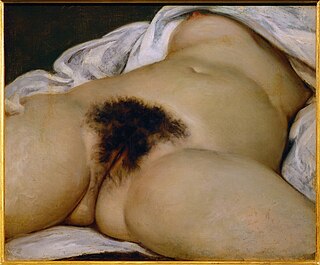
L'Origine du monde is a picture painted in oil on canvas by the French artist Gustave Courbet in 1866. It is a close-up view of the vulva and abdomen of a naked woman, lying on a bed with legs spread.

Léon Joseph Florentin Bonnat was a French painter, Grand Officer of the Légion d'honneur, art collector and professor at the Ecole des Beaux Arts.
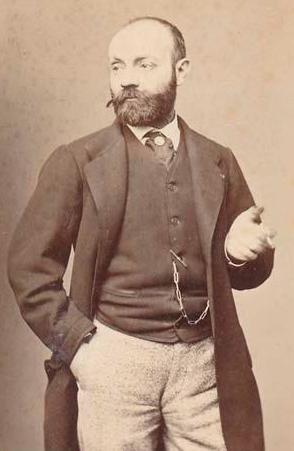
Gustave Clarence Rodolphe Boulanger was a French figurative painter and academic artist and teacher known for his Classical and Orientalist subjects.
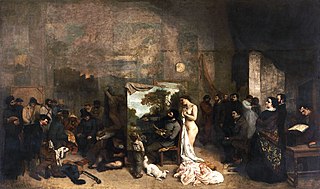
The Painter's Studio: A real allegory summing up seven years of my artistic and moral life is an 1855 oil on canvas painting by Gustave Courbet. It is located in the Musée d'Orsay in Paris, France.
Yan Pei-Ming, born 1 December 1960, is a Chinese painter. Since 1981 he has been living in Dijon, France. His most famous paintings are "epic-sized" portraits of Mao Zedong worked out in black and white or red and white. He works with big brushes, and his paintings are brought to life by the rapid brush strokes which structure the picture space.
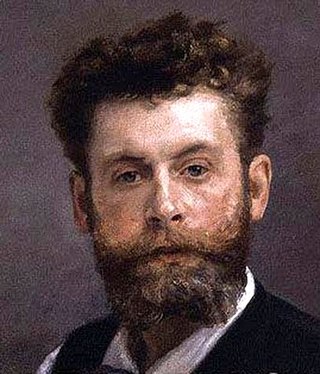
Alfred Philippe Roll was a French painter.

Étienne Carjat was a French journalist, caricaturist and photographer. He co-founded the magazine Le Diogène, and founded the review Le Boulevard. He is best known for his numerous portraits and caricatures of political, literary and artistic Parisian figures. His best-known work is the iconic portrait of Arthur Rimbaud which he took in October 1871. The location of much of his photography is untraceable after being sold to a Mr. Roth in 1923.

Le Sommeil is an erotic oil painting on canvas by French artist Gustave Courbet created in 1866. The painting, which depicts a lesbian couple, is also known as the Two Friends and Indolence and Lust.

During the Second French Empire, the reign of Emperor Napoleon III (1852–1870), Paris was the largest city in continental Europe and a leading center of finance, commerce, fashion, and the arts. The population of the city grew dramatically, from about one million to two million persons, partly because the city was greatly enlarged, to its present boundaries, through the annexation of eleven surrounding communes and the subsequent creation of eight new arrondissements.

The Wrestlers is a large 1853 painting by the French artist Gustave Courbet, now in the Museum of Fine Arts in Budapest]. It shows two men engaged in 'French wrestling', inspired by Greco-Roman wrestling. Documents reveal that it shows a match in the former hippodrome on the Champs-Élysées in Paris. His choice of such a huge canvas inspired Alexandre Falguière's 1875 The Wrestlers.
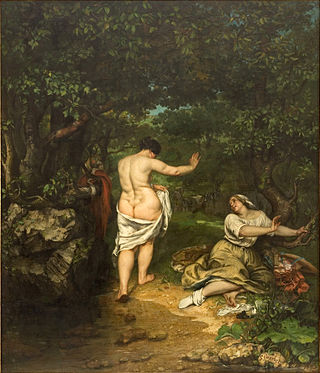
The Bathers is an oil-on-canvas painting by the French artist Gustave Courbet, first exhibited at the Paris Salon of 1853, where it caused a major scandal. It was unanimously attacked by art critics for the huge nude woman at its centre and the sketchy landscape background, both against official artistic canons. It was bought for 3000 francs by Courbet's future friend Alfred Bruyas, an art collector – this acquisition allowed the artist to become financially and artistically independent. It is signed and dated in the bottom right hand corner on a small rock. It has been in the musée Fabre in Montpellier since 1868.

The Happy Lovers is a title given to a c. 1844 painting by the French artist Gustave Courbet, now in the musée des Beaux-Arts de Lyon. One of its earlier titles when exhibited in 1855 at the Pavillon Courbet in Paris was The Waltz. It was sold in the Courbet sale of 1881 and bought by M. Hard and resold to M. Brame, before entering the collection of the musée des Beaux-Arts de Lyon in 1892. The engraver Félix Bracquemond, a friend of the painter, reproduced the work as an etching.

Self-Portrait with a Black Dog, Portrait of the Artist or Courbet with a Black Dog is an 1842 oil-on-canvas painting by the French artist Gustave Courbet, retouched by the artist in 1844. It is now in the Petit Palais in Paris.

Young Ladies Beside the Seine (Summer) (French - Les Demoiselles des bords de la Seine (été)) is an oil on canvas painting by Gustave Courbet. He painted it between late 1856 and early 1857 and presented it to the Paris Salon jury, which accepted it and exhibited it on 15 June 1857 with two portraits and three landscapes by the same artist.

Le Désespéré is an oil-on-canvas self-portrait by Gustave Courbet, produced in 1843–1845, early during his stay in Paris. It is now in the private collection of the Conseil Investissement Art BNP Paribas but was displayed in the Musée d'Orsay's 2007 Courbet exhibition.

Jo, the Beautiful Irishwoman is the title of a series of four oil on canvas bust-length portraits by Gustave Courbet. They all show the same redheaded Irish model Joanna Hiffernan looking in a mirror – she also modelled for Whistler. The works have minor differences in details and dimensions but their exact chronology is unknown. They are now in the Nationalmuseum, the Metropolitan Museum of Art, the Nelson-Atkins Museum of Art and a private collection.

Victor Chocquet was a French art collector and an ardent propagandist of Impressionism. As a senior editor at the Directorate-General of Customs and Indirect Taxes, he was present at all the exhibitions where he defended painters confronted with mockery and insults. His collection was huge. It was dispersed after his death in 1899. Many of the paintings are currently in American museums.

Empress Eugénie Surrounded by her Ladies in Waiting is an oil on canvas painting by the German artist Franz Xaver Winterhalter completed in 1855. It features depictions of the empress of France, Eugénie de Montijo, and eight of her ladies-in-waiting. The painting was displayed at the Palace of Fontainebleau during the regime of Eugénie's husband, Napoleon III. After Eugénie's exile to England, the painting was given to her, and later displayed in the entrance to her house at Farnborough Hill. It is currently on display at Château de Compiègne.



















